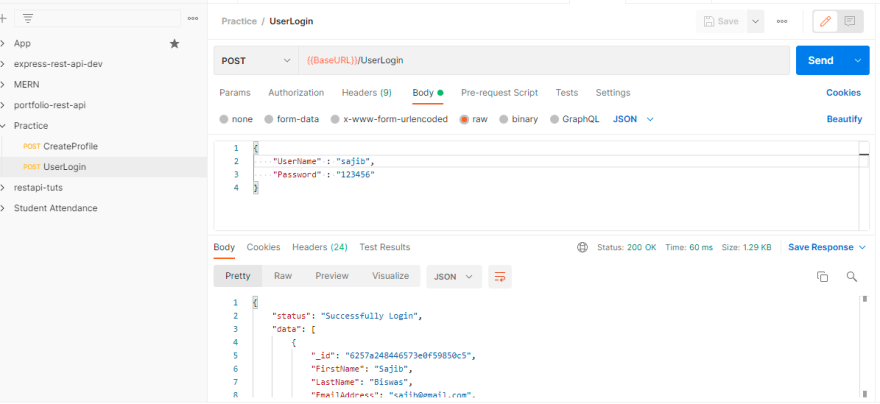An Interest In:
Web News this Week
- April 27, 2024
- April 26, 2024
- April 25, 2024
- April 24, 2024
- April 23, 2024
- April 22, 2024
- April 21, 2024
April 14, 2022 06:31 am GMT
Original Link: https://dev.to/bipon68/user-login-using-nodejs-1hi9
User login using NodeJS
Objective: In this article, you will know mongoose model, how to create user using node, router.
Pre-requisite Prior to completing this article, you should have already installed all pre-requisite tooling including: Visual Studio Code, Node Package Manager (NPM), Node, Postman, Mongo Compass.
Create a Model (ProfileModel.js)
const mongoose = require('mongoose')const DataSchema = mongoose.Schema({ FirstName : {type: String}, LastName : {type: String}, EmailAddress : {type: String}, MobileNumber : {type: String}, City : {type: String}, UserName : {type: String}, Password : {type: String}});const ProfileModel = mongoose.model('Profile', DataSchema)module.exports = ProfileModel;Create a Controller (ProfileController.js)
At first import ProfileModel. Declare a variable reqBody to store body data. Then create user using ProfileModel model
const ProfileModel = require("../models/ProfileModel");exports.CreateProfile = (req, res) => { let reqBody = req.body; ProfileModel.create(reqBody, (err, data) => { if(err){ res.status(400).json({status: "Failed to user create", data: err}) }else{ res.status(200).json({status: "Successfully user created", data: data}) } })}exports.UserLogin = (req, res) => { let UserName = req.body['UserName']; let Password = req.body['Password']; // res.status(200).json({status: "Success", data: Password}) ProfileModel.find({UserName, Password}, (err, data) => { if(err){ res.status(400).json({status: "Failed to login", data: err}) }else{ if(data.length > 0){ res.status(200).json({status: "Successfully Login", data: data}) }else{ res.status(401).json({status: "Unauthorized"}) } } })}The find() function is used to find particular data from the MongoDB database
Default configuration (app.js)
// Basic importconst express = require('express');const router = require('./src/routes/api')const app = new express();const bodyParser = require('body-parser')// Database lib importconst mongoose = require('mongoose')// Body parser implementapp.use(bodyParser.json())// MongoDB database connectionlet uri = 'mongodb://127.0.0.1:27017/PracticeDB'let options = {user: '', pass: ''}mongoose.connect(uri, options, (err) => { if(err){ console.log(err) }else{ console.log('Database Connection Success') }})// Routing Implementapp.use('/api/v1', router)// Undefined Route Implementapp.use("*", (req, res) => { res.status(404).json({status: "Failed", data: "Not Found"})})module.exports = app;Routes configuration (api.js)
const express = require('express');const ProfileController = require('../controller/ProfileController')const router = express.Router();router.post('/CreateProfile', ProfileController.CreateProfile)router.post('/UserLogin', ProfileController.UserLogin)module.exports = router;Index file (index.js)
const app = require('./app')app.listen(5000, function(){ console.log('Server run at @5000 port')})Now open the Postman and configure few thing like
Then login a user giving basic information and click Send Button
If giving wrong information then showing Unauthorized
Thanks for reading. Happy journey.
Reference
Original Link: https://dev.to/bipon68/user-login-using-nodejs-1hi9
Share this article:
Tweet

View Full Article
Dev To
 An online community for sharing and discovering great ideas, having debates, and making friends
An online community for sharing and discovering great ideas, having debates, and making friendsMore About this Source Visit Dev To

